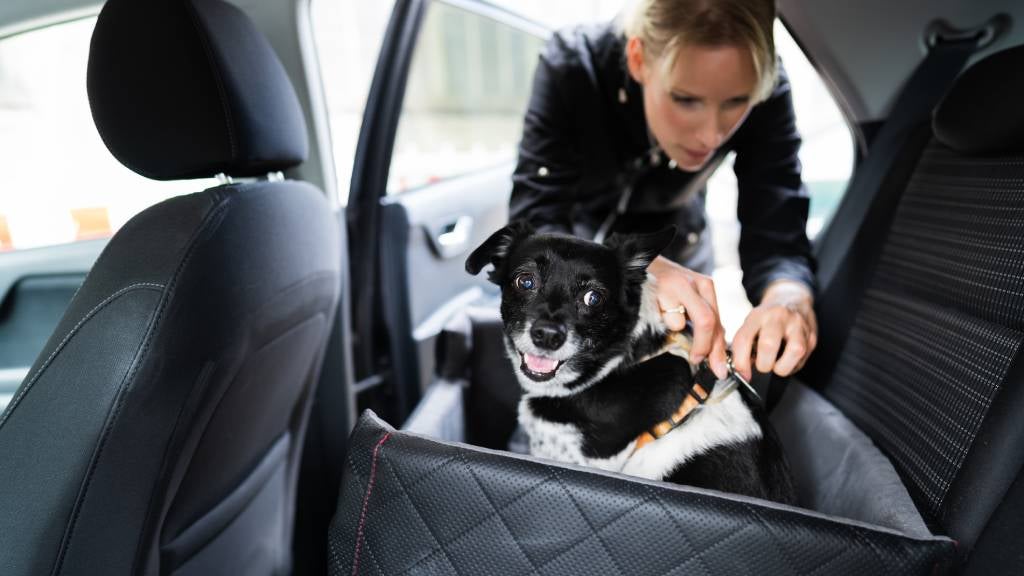Travelling with pets: Tips on how to travel safely

Most dogs love nothing more than a family outing, and with a motor vehicle, we can take them to all the special places we enjoy as well – parks, the countryside, dog-friendly beaches and even holiday locations. However, transporting pets in a car has some challenges or risks that you should keep in mind. It may take a bit of planning to set you and your canine friend up for safe travels.
Transporting your dog safely
The first step is to train your dog to be calm in the car. Feeling anxious about car travel is no fun for your dog and could even be a safety hazard if they become noisy and unsettled. It’s easier to start this training as puppies but even adult dogs who have negative associations with the car, such as being taken to the vet, can learn to be comfortable with the experience.
The key to getting your dog used to being in the car is to gradually create a positive association through treats – start by rewarding them just for getting into the car, then progress to short trips, and then longer drives. Using this approach, your dog will associate the car not just with treats but with fun outings. You should have them bounding in excitedly in no time! If your dog remains anxious about car travel, or experiences car sickness, your veterinarian is the best source of advice.
The use of safety belts is second nature to people, but did you know that for any drive with your dog you will need the canine equivalent? Restraining your dog in the car is essential for their safety and the safety of other passengers. This will prevent your dog from moving around and distracting the driver, which is a major cause of accidents, and even from jumping or falling out through the car window. In the unfortunate event of a collision, effective restraint also protects your dog from being thrown from the vehicle and can reduce injuries from sudden braking.
The sad reality is that, without being safely restrained, dogs being transported in vehicles can suffer severe and even fatal injuries. Despite this, many owners don’t take precautions, perhaps because their dog sits quietly in the car, but training is not enough.
Remember to check the laws and recommendations
While there is no blanket regulation about how to restrain your dog, there are penalties throughout Australia for owners who fail to secure their dog safely in some situations. As drivers, we’re all required to have proper control of our vehicles and the police can issue fines or demerit points if this is prevented by dogs jumping around, hanging out the window or otherwise being a distraction.
The strongest legislation is in NSW, where it’s illegal to drive with a pet in your lap as this could be deemed as a distraction. Queensland, South Australia, Victoria and Western Australia each have similar regulations around transporting pets on the road, including some restraint recommendations.
So how should you keep your dog safe when travelling in a vehicle? For dogs travelling inside the vehicle, the best advice is to keep them restrained in the back seat where they can travel safely with far less chance of distracting the driver. This also protects them from being seriously injured by exploding airbags in a collision. The types of restraint you can use include:
- Safety-tested dog safety belts, which attach to your dog’s harness and clip into the existing seat belts
- Pet crates that are securely placed and allow enough space for your dog to comfortably lie down, sit, stand, and turn around, or
- Behind the cargo barrier of a station wagon
Dogs travelling outside of a vehicle, like on the back of a ute or truck, need to be tethered or kept in a secure enclosure. Large fines may apply if you don’t secure your dog correctly in these situations.
Risks to avoid
A final safety warning is about heat stress. Most owners are aware to never leave their dogs in a hot car due to the risk of death from heat stress, but it’s important to understand that this can happen in a very short time – it only takes six minutes for a dog to die in a hot car. The temperature in a car can be double that of the outside temperature, even on a mild day, and you can’t prevent your dog from overheating just by parking in the shade, opening windows or using air conditioning.
Even if your dog is outdoors on the back of a ute, leaving them restrained for long periods in direct sunlight could pose a risk of heat stroke. It’s important to remember that dogs are much more sensitive to heat than humans are, so even if you feel comfortable, your dog may not feel the same.
Once you know how to drive safely with your dog, the fun part comes in planning your trip! There are lots of great areas suited to road trips with dogs throughout Australia that include dog-friendly beaches and pet accommodation options. You can prepare for your road trip by packing your pooch’s travel bag (including food, water, bowls, collar and leash, brush, toys, bedding and any medications), checking that their microchip details are up-to-date and finding contact details for veterinarians in the area you’ll be visiting. And don’t forget to stop for toilet breaks!
Driving with your dog can and should be a joyful experience. Our dogs love being with us and rely on us to always keep them safe. Car travel is no different. Once you have the safety issues sorted, you can focus on creating wonderful memories of drives and road trips with your furry friend. Another way to help protect your dog is by taking out Real Pet Insurance to reduce eligible vet bills and be reassured that your dog can have treatment as needed.
28 Sep 2021